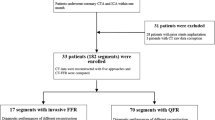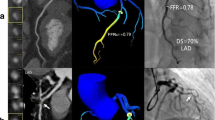Abstract
To evaluate the impact of an iterative reconstruction (IR) algorithm (advanced modeled iterative reconstruction, ADMIRE) on machine learning-based coronary computed tomography angiography–derived fractional flow reserve (CT-FFRML) measurements compared with filtered back projection (FBP). 170 plaque-containing vessels in 107 patients were included. CT-FFRML values were measured and compared among 5 imaging reconstruction algorithms (FBP and ADMIRE at strength levels of 1, 2, 3 and 5). The plaques were classified as, ‘calcified” or “noncalcified” and “≥ 50% stenosis” or “< 50% stenosis’, a total of four subgroups by consensus. There were no significant differences of CT-FFRML values among the FBP and ADMIRE 1, 2, 3 and 5 groups wherever comparisons were done at the level of subgroups (P = 0.676, 0.414, 0.849, 0.873, respectively) or overall (P = 0.072). There were 20, 21, 19, 19 and 29 vessels with lesion-specific ischemia (CT-FFRML ≤ 0.80) in FBP and ADMIRE 1, 2, 3 and 5 datasets, respectively, but no statistical differences were found (P = 0.437). Compared with CT-FFRML value of FBP dataset, the CT-FFRML values of 9 (5.3%) vessels from 8 patients (7.5%) in ADMIRE5 dataset switched from above 0.8 to below or equal to 0.8. There were no significant differences of the CT-FFRML values among the FBP and IR image algorithms at different strength levels. However, high iterative strength level (ADMIRE 5) was not recommended, which might have an impact on diagnosis of lesion-specific ischemia, although changes only occurred in a modest number of subjects.



Similar content being viewed by others
References
Tesche C, De Cecco CN, Caruso D, Baumann S, Renker M, Mangold S, Dyer KT, Varga-Szemes A, Baquet M, Jochheim D, Ebersberger U, Bayer RR, Hoffmann E, Steinberg DH, Schoepf UJ (2016) Coronary CT angiography derived morphological and functional quantitative plaque markers correlated with invasive fractional flow reserve for detecting hemodynamically significant stenosis. J Cardiovasc Comput Tomogr 10(3):199–206. https://doi.org/10.1016/j.jcct.2016.03.002
Chow BJ, Small G, Yam Y, Chen L, Achenbach S, Al-Mallah M, Berman DS, Budoff MJ, Cademartiri F, Callister TQ, Chang HJ, Cheng V, Chinnaiyan KM, Delago A, Dunning A, Hadamitzky M, Hausleiter J, Kaufmann P, Lin F, Maffei E, Raff GL, Shaw LJ, Villines TC, Min JK (2011) Incremental prognostic value of cardiac computed tomography in coronary artery disease using CONFIRM: COroNary computed tomography angiography evaluation for clinical outcomes: an InteRnational Multicenter registry. Circ Cardiovasc Imaging 4(5):463–472. https://doi.org/10.1161/circimaging.111.964155
Miller JM, Rochitte CE, Dewey M, Arbab-Zadeh A, Niinuma H, Gottlieb I, Paul N, Clouse ME, Shapiro EP, Hoe J, Lardo AC, Bush DE, de Roos A, Cox C, Brinker J, Lima JA (2008) Diagnostic performance of coronary angiography by 64-row CT. N Engl J Med 359(22):2324–2336. https://doi.org/10.1056/NEJMoa0806576
Itu L, Rapaka S, Passerini T, Georgescu B, Schwemmer C, Schoebinger M, Flohr T, Sharma P (1985) Comaniciu D (2016) A machine-learning approach for computation of fractional flow reserve from coronary computed tomography. J Appl Physiol 121(1):42–52. https://doi.org/10.1152/japplphysiol.00752.2015
Tesche C, De Cecco CN, Baumann S, Renker M, McLaurin TW, Duguay TM, Bayer RR 2nd, Steinberg DH, Grant KL, Canstein C, Schwemmer C, Schoebinger M, Itu LM, Rapaka S, Sharma P, Schoepf UJ (2018) Coronary CT angiography-derived fractional flow reserve: machine learning algorithm versus computational fluid dynamics modeling. Radiology 288(1):64–72. https://doi.org/10.1148/radiol.2018171291
Coenen A, Kim YH, Kruk M, Tesche C, De Geer J, Kurata A, Lubbers ML, Daemen J, Itu L, Rapaka S, Sharma P, Schwemmer C, Persson A, Schoepf UJ, Kepka C, Hyun Yang D, Nieman K (2018) Diagnostic accuracy of a machine-learning approach to coronary computed tomographic angiography-based fractional flow reserve: result from the MACHINE consortium. Circ Cardiovasc Imaging 11(6):e007217. https://doi.org/10.1161/CIRCIMAGING.117.007217
Geyer LL, Schoepf UJ, Meinel FG, Nance JW, Bastarrika G, Leipsic JA, Paul NS, Rengo M, Laghi A, De Cecco CN (2015) State of the art: iterative CT reconstruction techniques. Radiology 276(2):338–356. https://doi.org/10.1148/radiol.2015132766
Gordic S, Morsbach F, Schmidt B, Allmendinger T, Flohr T, Husarik D, Baumueller S, Raupach R, Stolzmann P, Leschka S, Frauenfelder T, Alkadhi H (2014) Ultralow-dose chest computed tomography for pulmonary nodule detection: first performance evaluation of single energy scanning with spectral shaping. Invest Radiol 49(7):465–473. https://doi.org/10.1097/RLI.0000000000000037
Gordic S, Desbiolles L, Stolzmann P, Gantner L, Leschka S, Husarik DB, Alkadhi H (2014) Advanced modelled iterative reconstruction for abdominal CT: qualitative and quantitative evaluation. Clin Radiol 69(12):E497–E504. https://doi.org/10.1016/j.crad.2014.08.012
Choy S, Parhar D, Lian K, Schmiedeskamp H, Louis L, O'Connell T, McLaughlin P, Nicolaou S (2019) Comparison of image noise and image quality between full-dose abdominal computed tomography scans reconstructed with weighted filtered back projection and half-dose scans reconstructed with improved sinogram-affirmed iterative reconstruction (SAFIRE*). Abdom Radiol 44(1):355–361. https://doi.org/10.1007/s00261-018-1687-9
Solomon J, Wilson J, Samei E (2015) Characteristic image quality of a third generation dual-source MDCT scanner: noise, resolution, and detectability. Med Phys 42(8):4941–4953. https://doi.org/10.1118/1.4923172
Takx RA, Willemink MJ, Nathoe HM, Schilham AM, Budde RP, de Jong PA, Leiner T (2014) The effect of iterative reconstruction on quantitative computed tomography assessment of coronary plaque composition. Int J Cardiovasc Imaging 30(1):155–163. https://doi.org/10.1007/s10554-013-0293-8
Gassenmaier T, Distelmaier I, Weng AM, Bley TA, Klink T (2017) Impact of advanced modeled iterative reconstruction on interreader agreement in coronary artery measurements. Eur J Radiol 94:201–208. https://doi.org/10.1016/j.ejrad.2017.06.029
Solomon J, Mileto A, Ramirez-Giraldo JC, Samei E (2015) Diagnostic performance of an advanced modeled iterative reconstruction algorithm for low-contrast detectability with a third-generation dual-source multidetector CT scanner: potential for radiation dose reduction in a multireader study. Radiology 275(3):735–745. https://doi.org/10.1148/radiol.15142005
Schaller F, Sedlmair M, Raupach R, Uder M, Leii M (2016) Noise reduction in abdominal computed tomography applying iterative reconstruction (ADMIRE). Acad Radiol 23(10):1230–1238. https://doi.org/10.1016/j.acra.2016.05.016
Mastrodicasa D, Albrecht MH, Schoepf UJ, Varga-Szemes A, Jacobs BE, Gassenmaier S, De Santis D, Eid MH, van Assen M, Tesche C, Mantini C, De Cecco CN (2018) Artificial intelligence machine learning-based coronary CT fractional flow reserve (CT-FFRML): Impact of iterative and filtered back projection reconstruction techniques. J Cardiovasc Comput Tomogr. https://doi.org/10.1016/j.jcct.2018.10.026
Leipsic J, Abbara S, Achenbach S, Cury R, Earls JP, Mancini GJ, Nieman K, Pontone G, Raff GL (2014) SCCT guidelines for the interpretation and reporting of coronary CT angiography: a report of the Society of Cardiovascular Computed Tomography Guidelines Committee. J Cardiovasc Comput Tomogr 8(5):342–358. https://doi.org/10.1016/j.jcct.2014.07.003
Min JK, Koo BK, Erglis A, Doh JH, Daniels DV, Jegere S, Kim HS, Dunning A, Defrance T, Leipsic J (2012) Effect of image quality on diagnostic accuracy of noninvasive fractional flow reserve: results from the prospective multicenter international DISCOVER-FLOW study. J Cardiovasc Comput Tomogr 6(3):191–199. https://doi.org/10.1016/j.jcct.2012.04.010
Tonino PA, De-Bruyne B, Pijls NH, Siebert U, Ikeno F, van’t Veer M, Klauss V, Manoharan G, Engstrom T, Oldroyd KG, Ver Lee PN, MacCarthy PA, Fearon WF, Investigators FS (2009) Fractional flow reserve versus angiography for guiding percutaneous coronary intervention. N Engl J Med 360(3):213–224. https://doi.org/10.1056/NEJMoa0807611
Dey D, Gaur S, Ovrehus KA, Slomka PJ, Betancur J, Goeller M, Hell MM, Gransar H, Berman DS, Achenbach S, Botker HE, Jensen JM, Lassen JF, Norgaard BL (2018) Integrated prediction of lesion-specific ischaemia from quantitative coronary CT angiography using machine learning: a multicentre study. Eur Radiol 28(6):2655–2664. https://doi.org/10.1007/s00330-017-5223-z
Motwani M, Dey D, Berman DS, Germano G, Achenbach S, Al-Mallah MH, Andreini D, Budoff MJ, Cademartiri F, Callister TQ, Chang HJ, Chinnaiyan K, Chow BJ, Cury RC, Delago A, Gomez M, Gransar H, Hadamitzky M, Hausleiter J, Hindoyan N, Feuchtner G, Kaufmann PA, Kim YJ, Leipsic J, Lin FY, Maffei E, Marques H, Pontone G, Raff G, Rubinshtein R, Shaw LJ, Stehli J, Villines TC, Dunning A, Min JK, Slomka PJ (2017) Machine learning for prediction of all-cause mortality in patients with suspected coronary artery disease: a 5-year multicentre prospective registry analysis. Eur Heart J 38(7):500–507. https://doi.org/10.1093/eurheartj/ehw188
Renker M, Nance JW Jr, Schoepf UJ, O'Brien TX, Zwerner PL, Meyer M, Kerl JM, Bauer RW, Fink C, Vogl TJ, Henzler T (2011) Evaluation of heavily calcified vessels with coronary CT angiography: comparison of iterative and filtered back projection image reconstruction. Radiology 260(2):390–399. https://doi.org/10.1148/radiol.11103574
Chen B, Ramirez Giraldo JC, Solomon J, Samei E (2014) Evaluating iterative reconstruction performance in computed tomography. Med Phys 41(12):121913. https://doi.org/10.1118/1.4901670
Benz DC, Fuchs TA, Grani C, Studer Bruengger AA, Clerc OF, Mikulicic F, Messerli M, Stehli J, Possner M, Pazhenkottil AP, Gaemperli O, Kaufmann PA, Buechel RR (2018) Head-to-head comparison of adaptive statistical and model-based iterative reconstruction algorithms for submillisievert coronary CT angiography. Eur Heart J Cardiovasc Imaging 19(2):193–198. https://doi.org/10.1093/ehjci/jex008
Puchner SB, Ferencik M, Maurovich-Horvat P, Nakano M, Otsuka F, Kauczor H-U, Virmani R, Hoffmann U, Schlett CL (2014) Iterative image reconstruction algorithms in coronary CT angiography improve the detection of lipid-core plaque—a comparison with histology. Eur Radiol 25(1):15–23. https://doi.org/10.1007/s00330-014-3404-6
Wang R, Schoepf UJ, Wu RZ, Nance JW, Lv BA, Yang H, Li F, Lu DX, Zhang ZQ (2014) Diagnostic accuracy of coronary CT angiography: comparison of filtered back projection and iterative reconstruction with different strengths. J Comput Assist Tomogr 38(2):179–184. https://doi.org/10.1097/Rct.0000000000000005
Pijls NH, De Bruyne B, Peels K, Van Der Voort PH, Bonnier HJ, Bartunek JKJJ, Koolen JJ (1996) Measurement of fractional flow reserve to assess the functional severity of coronary-artery stenoses. N Engl J Med 334(26):1703–1708. https://doi.org/10.1056/NEJM199606273342604
Sand NPR, Veien KT, Nielsen SS, Norgaard BL, Larsen P, Johansen A, Hess S, Deibjerg L, Husain M, Junker A, Thomsen KK, Rohold A, Jensen LO (2018) Prospective comparison of FFR derived from coronary CT angiography with SPECT perfusion imaging in stable coronary artery disease. The ReASSESS study. JACC Cardiovasc Imaging 11(11):1640–1650. https://doi.org/10.1016/j.jcmg.2018.05.004
Coenen A, Lubbers MM, Kurata A, Kono A, Dedic A, Chelu RG, Dijkshoorn ML, Gijsen FJ, Ouhlous M, van Geuns RJM, Nieman K (2015) Fractional flow reserve computed from noninvasive CT angiography data: diagnostic performance of an on-site clinician-operated computational fluid dynamics algorithm. Radiology 274(3):674–683. https://doi.org/10.1148/radiol.14140992
Rother J, Moshage M, Dey D, Schwemmer C, Trobs M, Blachutzik F, Achenbach S, Schlundt C, Marwan M (2018) Comparison of invasively measured FFR with FFR derived from coronary CT angiography for detection of lesion-specific ischemia: results from a PC-based prototype algorithm. J Cardiovasc Comput Tomogr 12(2):101–107. https://doi.org/10.1016/j.jcct.2018.01.012
Min JK, Leipsic J, Pencina MJ, Berman DS, Koo BK, van Mieghem C, Erglis A, Lin FY, Dunning AM, Apruzzese P, Budoff MJ, Cole JH, Jaffer FA, Leon MB, Malpeso J, Mancini GBJ, Park SJ, Schwartz RS, Shaw LJ, Mauri L (2012) Diagnostic accuracy of fractional flow reserve from anatomic CT angiography. JAMA J Am Med Assoc 308(12):1237–1245. https://doi.org/10.1001/2012.jama.11274
Norgaard BL, Leipsic J, Gaur S, Seneviratne S, Ko BS, Ito H, Jensen JM, Mauri L, De Bruyne B, Bezerra H, Osawa K, Marwan M, Naber C, Erglis A, Park SJ, Christiansen EH, Kaltoft A, Lassen JF, Botker HE, Achenbach S, Grp NTS (2014) Diagnostic performance of noninvasive fractional flow reserve derived from coronary computed tomography angiography in suspected coronary artery disease: the NXT trial (analysis of coronary blood flow using CT angiography: next steps). J Am Coll Cardiol 63(12):1145–1155. https://doi.org/10.1016/j.jacc.2013.11.043
Acknowledgements
Thank American Journal Experts for providing language help.
Author information
Authors and Affiliations
Contributions
All authors contributed to the study conception and design. Material preparation, data collection and analysis were performed by [SL], [CC], [LQ] and [SG]. Conceptualization, resources, and methodology were performed by [WY], [HZ].and [FY]. The first draft of the manuscript was written by [SL]. All authors commented on previous versions of the manuscript. All authors read and approved the final manuscript.
Corresponding author
Ethics declarations
Conflict of interest
The authors declare that they have no conflict of interest.
Ethical approval
The approval for this study had been granted by the local Institutional Review Board prior to its conduct and informed consent was waived. The study therefore had been performed in accordance with the ethical standards laid down in the 1964 Declaration of Helsinki and its later amendments. No patient identifiers were collected, and details that might disclose the identity of the subjects under study should were omitted.
Additional information
Publisher's Note
Springer Nature remains neutral with regard to jurisdictional claims in published maps and institutional affiliations.
Rights and permissions
About this article
Cite this article
Li, S., Chen, C., Qin, L. et al. The impact of iterative reconstruction algorithms on machine learning-based coronary CT angiography-derived fractional flow reserve (CT-FFRML) values. Int J Cardiovasc Imaging 36, 1177–1185 (2020). https://doi.org/10.1007/s10554-020-01807-7
Received:
Accepted:
Published:
Issue Date:
DOI: https://doi.org/10.1007/s10554-020-01807-7




